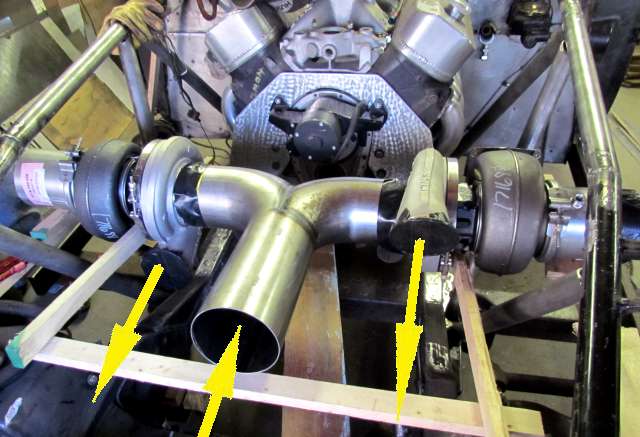....In my simple world I just want to recover as much altitude as I can. So if I'm at 29.95 at home & 25.50 at Bonneville I would like to get the ~4" hg back. This is to keep my turbo pressure ratio as close to the dyno test as possible. If the we run at a higher altitude with no pressure recovery the turbine will spin faster to make up for the higher pressure ratio and will cause more back pressure. ...
I'll also be interested in what Woody has to say.
I ran some numbers through BW's Matchbot using the turbos we have on the Stude but for a 500 ci motor, vs. the 572 in the car, at 6500 rpm.
Altitude.. temp.. lbs. boost..Compressor Pressure Ratio..HP..Compressor Outlet Temp..Exh. Manifold Pres
Sea level.....90.......16#......................2.16..............1385...............296 F.......................18#
4600...........90.......16#......................2.33..............1297...............319 F.......................18#
4600...........90.......18#......................2.49..............1384...............339 F.......................20#
From sea level to 4600 feet you loose about 100 HP at the same boost and the air temps out of the compressor go up about 23 degrees. To get that back you need to run 2 more lbs. of boost 18 vs. 16 and that raises the compressor outlet temps 43 deg. over sea level. Also as you mentioned the Pressure Ratio has gone from 2.16 to 2.33 and then 2.49.
So making up any of the altitude loss is going to be big in the terms of the compressor not having to work so hard to make up for it and the intercooler also doesn't have to cool hotter air.
Our present setup on the Studebaker sucks and we know it, in that we have no plenum area before the compressor inlets. This might be fixed this year but I kind of doubt it at this time. The only saving grace for us is that we are not trying to run anywhere near what the combo should be capable of if everything was maximized.
How about it Woody, would feeding the air from the scoop inlet into a crude box ....

...before the two turbos help in the area above where the "Y" is now. They would each draw out of opposite sides of the box. Would this help our pressure recovery? We would also make the track from the inlet to the box a constantly expanding volume. We did that on the scoop for the old motor with the inlet track expanding from the inlet to the bug catcher on the roots blower, no plenum though.
One thing we all find is that sometimes what is best either can't be done in time if you ever want to run or it just won't fit in the car....


Sum